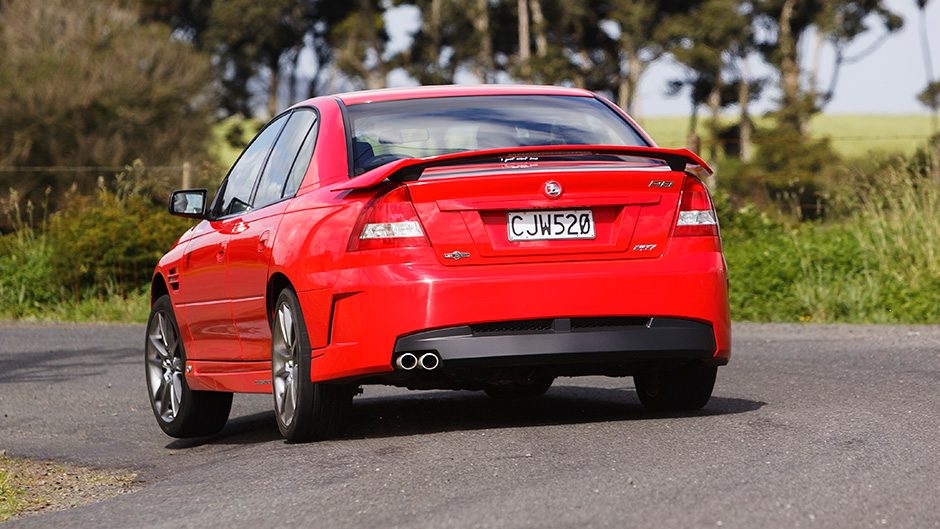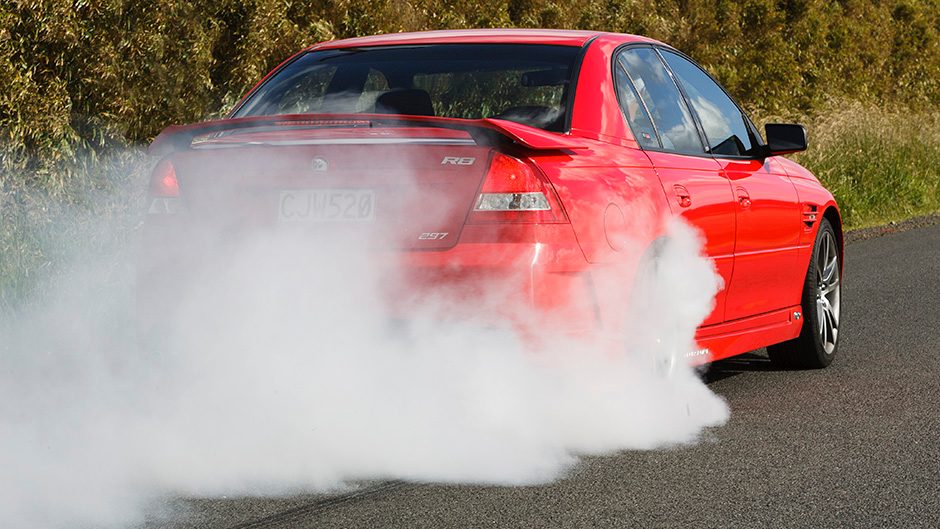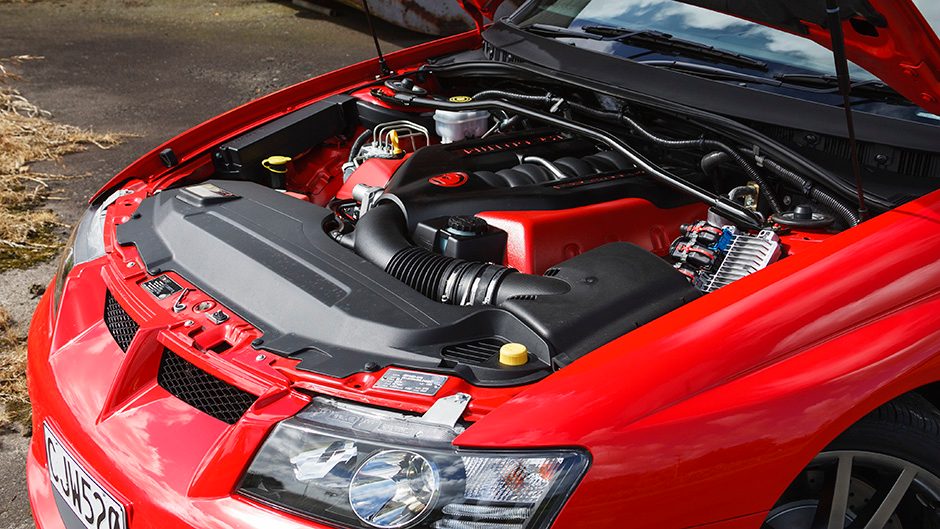After a weekend away with the biggest, baddest gun in the HSV armoury, I’m a believer in absolute power, though it tends to corrupt your sanity. In 1988, when HSV first opened its doors, its biggest banger produced 180kW. Just 15 years down the track, and its top dog now mauls the opposition with 297kW, or 305kW DIN, in comparable Ford terms. And the Alpha dog happens to sport the largest engine ever – at least one that costs less than six figures. For what it’s worth, the only lumps bigger are in luxo barges like the 760Li (5972cc), the SL 65 AMG (5980cc) and the R-R Phantom (6749cc). The odd supercar, like the Zonda, as well (7291cc). But none offers the bang for buck of the LS2, which now powers most of the latest VZ HSVs, including the R8 seen here, costing $88,900 (manual or auto). The LS1 5.7L V8 might have been bigger than Ford’s equivalent 5.4 litre ‘Boss 290’ but it didn’t crank out as much torque (520 versus 510Nm). The adoption of the bored LS2 donk puts the General firmly back in command of the pack, at least of the V8s. A six-packing, turbo-toting upstart from Ford, the Typhoon, blows them all away with 550Newts at 2000rpm! What used to be a power race is turning into a torque-fest.
Still, the heightened output the LS2 engine brings to HSV means the R8 comes within a whisker of equalling the outgoing GTS’s output of 300kW, while it pumps out a hulking 530Nm of torque at 4400rpm. Critically, there’s a minimum of 463 of these Enems (87 per cent) ready to pin you back into your leather pew from 1600rpm right through to 6000rpm. Which is where the LS2 puts to rights the criticisms of the LS1 mill – this engine didn’t really start breathing fire until the tacho was hovering above 4000rpm. We can state categorically that the laxity at low revs has been flushed clean away. Even with its carryover four-speed automatic transmission, the Shredder will turn itself into an impromptu smoke machine with minimal effort – just a prod of throttle has that pea-soup fog rolling in.

The extra grunt is the result of not just the added displacement: a raised compression ratio, recalibrated ECU and larger throttle-body diameter contribute, while the slightly lower differential ratio helps improve performance in the auto. To the point where it’s actually quicker than the manual version: 0-100km/h supposedly drops from a claimed best of 5.6 seconds to 5.1, with the new six-speed manual taking 5.2s. Our evaluation auto R8 (SN R8 0031) had only 600 kilometres on the odo when we ran the VBOX numbers, so consider its best time of 5.78s very much an indicator only. We found the limiting factor to be – not unsurprisingly – wheelspin. The Shredder is all too keen to regale any crowd with its smokin’ party trick. Which is all very well in the dry, in the right circumstances, but excess slip angle is the last thing you want in the wet with any speed on. Fortunately, there’s a TC button. In the LS1 HSVs, the TC system would fight you for control of the gas pedal, like a lap dog humping your ankle. Not any longer, thanks to a new electronic throttle control, permitting the use of an up-rated ABS/TC system, the Bosch v8.0 (a version which seems appropriate here). When the rears are raring to spin up, there’s merely an interruption in transmission of power as the Shredmeister is brought to heel, and then he’s off, barking madly again. And what a howl – the extra capacity has dropped its exhaust note half an octave, and it sounds a riot under the hammer.
Alongside TC you can expect stability control in future, with the change to the new Zeta platform come VE time. Which is also when the four-speed gearbox will make way for a six-speeder. It can’t come soon enough. The existing gearbox has lost its ‘power’ mode button, because HSV felt performance was sufficient without it. It’s right in a numerical sense, but when coasting along and preparing to overtake, you soon lose patience with the V8 grunting away in top. Had the power mode been retained, the tranny might have been a little more onto it, gear-wise. As is, the auto isn’t the version that relishes pussyfooting. If you want to pass, best to do it at light speed. Mash that loud pedal, and then it bangs down through third and into second for a display of acceleration that’s just breathtaking from the occupant’s point of view, and terrifying if you’re being overtaken unbeknownst.

Alongside TC you can expect stability control in future, with the change to the new Zeta platform come VE time. Which is also when the four-speed gearbox will make way for a six-speeder. It can’t come soon enough. The existing gearbox has lost its ‘power’ mode button, because HSV felt performance was sufficient without it. It’s right in a numerical sense, but when coasting along and preparing to overtake, you soon lose patience with the V8 grunting away in top. Had the power mode been retained, the tranny might have been a little more onto it, gear-wise. As is, the auto isn’t the version that relishes pussyfooting. If you want to pass, best to do it at light speed. Mash that loud pedal, and then it bangs down through third and into second for a display of acceleration that’s just breathtaking from the occupant’s point of view, and terrifying if you’re being overtaken unbeknownst.
Evidently, the new, quick-throw Tremec M12 six-speed manual transmission transforms the R8 in this regard, pulling high gears with more authority. Still, the auto’s malaise is no reflection on the vigour of the new engine. Where the LS1 required a healthy flow of revs before it was in the zone, the LS2 is drooling happily by 2500rpm, wagging its tail at 3500, and running circles around everything once the needle sweeps past 4500rpm. For minimum overtaking time, you’re looking at 3.6s for 80-120km/h where the auto LS1 R8 was fair flailing itself to break 4.0s.

Another performance area that takes a hike is the way the car counters its considerable forward thrust. The four-pot premium brake package, formerly an option, now comes standard on the R8, and is inspirational. These brakes offer the same sort of raw unbridled power, figuratively speaking, that the LS2 dishes out, and can be feathered to exactly the desired amount of retardation. Its 100-0km/h stoppie of just on 35 metres is respectable given its kerb weight of 1734kg, but doesn’t do the brakes justice in the real world. If you’re the type that drives an HSV like a loon every possible opportunity, then you’ll probably like the ride quality of the latest R8 because it’s firm and controlled, and that means less roll and more grip, but it’s occasionally crashy. Still, there’s grip aplenty (except when the Shredder is off doing its dragon imitations) thanks to the new 19-inch rims shod with 245/35 P Zero Rossos. And every bit is needed, seeing that HSV quotes a top speed of 274km/h. If you’ve a beef with the ride, there’s always the Ohlins adjustable suspension available as a cost option.
Visually, the new R8 is more sophisticated, swapping its testosterone aftershave for a dab of eau de toilette. Which means it’s more easily mistaken for lesser Commodores. But mistake and provoke the Shredder at your peril.
If, as Benjamin Franklin once said, “Beer is proof that God loves us and wants us to be happy”, then a couple of hundred years on, I’d venture that the same goes for the LS2.
| Model | 2005 HSV Clubsport R8 |
| Price | $88,900 |
| Engine | 5967cc, V8, EFI, 297kW/Nm |
| Drivetrain | 4-speed auto, rear-wheel drive |
| Fuel Use | 15.5L/100km |
| C02 Output | N.A. g/km |
| 0-100km/h | 5.78sec |
| Weight | 1734kg |


